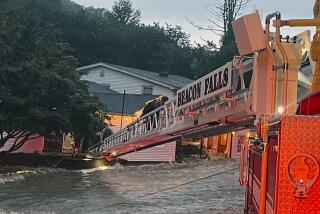Tornadoes’ Death Toll Rises to 90 : Thousands in Ohio, Pennsylvania Left Homeless in Storms
- Share via
The death toll climbed to 90 late Saturday as disaster workers in Ohio, Pennsylvania and Ontario, Canada, used heavy machinery to dig through warlike devastation left behind by the worst outbreak of tornadoes to tear through the Great Lakes region in more than 40 years.
Large portions of cities and towns in Ohio and Pennsylvania were flattened, cars were tossed about as if they were made of cardboard, bark was stripped from trees and telephone poles were ripped from the ground like twigs by the powerful wave of storms that left hundreds injured, thousands homeless and tens of millions of dollars of damage in their wake.
After flying over the devastation, Pennsylvania Gov. Dick Thornburgh said: “It’s got to be seen to be believed . . . . Carpet bombing has been carried out in this area.”
Power Out in Some Areas
Late Saturday, some areas hit by the storm were still without power and telephone service, while police using dogs moved through the destruction looking for injured survivors and bodies.
Northwest Pennsylvania was hardest hit during the seven hours that the storms rampaged through the upper Ohio Valley, unleashing at least 27 twisters from roiling, black clouds. The first killer storm hit at 5:05 p.m. Friday. Pennsylvania disaster officials said that the last storm in the state struck about 2 a.m. Saturday.
By late Saturday, 61 persons were confirmed dead in the state, said Darcey Charney, spokeswoman for the Pennsylvania Emergency Management Agency. She said that until Friday, tornadoes had claimed only three lives in the state since 1953.
‘This Came So Fast’
“We have so much better tracking, the weather service can warn people,” Charney said. “But this came so fast, people weren’t expecting it.”
Hardest hit was the community of Albion, where up to a quarter of the town was swept away by the swirling winds.
Another 16 persons were confirmed dead in Ohio, where it took until Saturday afternoon to extinguish gas-fed fires in Newton Falls. Little remained of the small community. There alone, up to 400 families were reported homeless, and the entire central business district was destroyed. Near Youngstown, 81 homes in the community of Niles were destroyed and 63 more severely damaged.
“If it hadn’t been for the (warning) sirens, the death toll might have been higher,” Ohio National Guard Maj. Calvin Taylor said, adding that in Newton Falls there was only one injury in an American Legion Hall where 150 persons took shelter under tables just before a tornado tore the roof off the building.
Thirteen persons were confirmed dead in Ontario, Canada, where the storm moved across the countryside, selectively striking farmsteads, towns and a shopping center. Injuries and damage were also reported in upstate New York, near Buffalo and Niagara Falls.
In the United States and Canada, more than 25 communities reported damage.
In Ohio and Pennsylvania, more than 800 National Guard troops joined local and state law enforcement personnel and Red Cross workers to search for additional victims and to prevent looting. In Ontario, Army troops were on patrol.
In terms of deaths, it was the worst recorded swarm of tornadoes ever to sweep across Pennsylvania, the worst to hit the upper Ohio Valley since June 23, 1944, and the worst to hit the United States since April, 1974.
The storms were unusually intense, weather experts said, because they were fed by a fast-moving front that swept across the Midwest on Friday, whipping up massive clouds of dust in Iowa and Illinois and triggering severe thunderstorms in Michigan.
At least three of the tornadoes stayed on the ground for more than 45 miles as they tore across the rolling eastern Ohio and western Pennsylvania countryside--more than 10 times the average distance traveled by tornadoes when they touch down, according to Edward W. Ferguson, assistant director of the National Severe Storm Center in Kansas City.
Ferguson, a tornado expert, said that the storms were fed by parallel jet streams at 35,000 feet, racing eastward at 125 m.p.h.--more than twice their normal speed of about 50 m.p.h.
Over the upper Ohio Valley, the jet streams split apart, one moving to the northeast and forming a counterclockwise pool of air, the other moving to the southeast and forming a clockwise air mass.
The motion of these two huge pools of air in the upper atmosphere rapidly sucked warm, moist air up from the earth’s surface and mixed it with the colder air aloft, forming the severe thunderstorms.
Disaster Areas Declared
Red Cross workers were helping victims in 21 counties in Ohio and Pennsylvania. After tours of the region, Thornburgh declared disasters in 10 counties, and Ohio Gov. Richard F. Celeste included five counties in a similar declaration.
Here is a partial list of communities hit by the violent weather:
--Pennsylvania: Albion, Adamsville, Atlantic, Beaver Falls, Cherrytree, Cochranton, Cooperstown, Corry, Cranesville, Greenfield, Jamestown, Kane City, Linesville and Wheatland.
--Ohio: Hubbard Township, Newton Falls, New Waterford, Niles, Lordstown and Utica.
--Ontario: Barrie, Alliston, Grand Valley, Orangeville and Shelburne.
More to Read
Sign up for Essential California
The most important California stories and recommendations in your inbox every morning.
You may occasionally receive promotional content from the Los Angeles Times.










